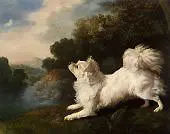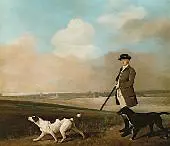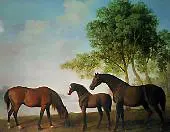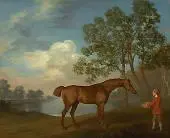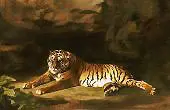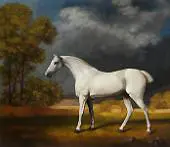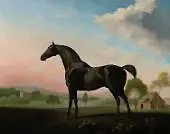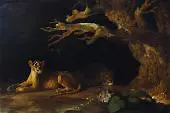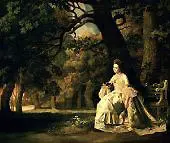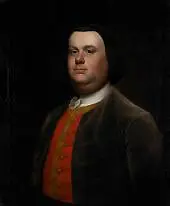George Stubbs Oil Painting Reproductions
George Stubbs replica paintings on Canvas for sale
Exploring the Famous Paintings of George Stubbs
Who was George Stubbs?
George Stubbs was an English painter and anatomist best known for his famous horse paintings. His attention to detail and ability to capture the essence of these majestic creatures made him the master of equine art.
In his oil paintings, George Stubbs went beyond mere representations of horses; he delved deeper into the intricate details of their anatomy, exploring their muscular structure and movements with unparalleled precision and accuracy. His keen observation and understanding of the equine form allowed him to create lifelike and three-dimensional oil paintings that bring the animals to life on the canvas. By meticulously capturing the most minor details, from the curves of their muscles to the flick of their tails, Stubbs created a sense of realism and authenticity unparalleled in his time.
Come with us on an exploration of the life and famous paintings of George Stubbs.
Early Life and Influences
He was born in Liverpool in 1724 to John and Mary Stubbs. His father was a leather dresser, working on finished hides so that they were waterproof and flexible. The finished leather would then be used by saddle and bridle makers.
George Stubbs' humble beginnings in Liverpool can be traced back to a small working-class neighborhood where he was born and raised. Growing up in modest surroundings, he discovered his passion for art at a young age, often spending hours doodling and sketching in his spare time.
George Stubbs was largely self-taught. He spent much of his early career studying the anatomy of horses, even dissecting horses to gain a deeper understanding of their structure. This dedication to studying horse anatomy is evident in his famous horse paintings, where he captures the physicality and spirit of these majestic creatures with unparalleled accuracy.
Despite lacking formal training or access to expensive art supplies, George Stubbs' determination and raw talent pushed him to excel. He used whatever materials he could get his hands on, from charcoal and pencil to old paintbrushes and scrap paper, to create his early masterpiece paintings.
Therefore, it can be said that Stubbs' artistic journey began against all odds, but it was precisely these humble beginnings that shaped him into the famous artist we know today.
Stubbs’ journey to Italy and exposure to Classical Art
George Stubbs' journey to Italy in 1754 was an experience that would forever influence his artistic perspective. As he wandered through the hallowed halls of renowned galleries and museums, Stubbs marveled at the impeccable attention to detail. He was captivated by the harmonious balance of composition and the arresting realism so flawlessly captured in the Classical Art and Renaissance paintings he saw.
This seminal moment was a pivotal turning point for George Stubbs, igniting a deep appreciation for classical art.
George Stubbs Famous Horse Paintings
Whistlejacket painting by George Stubbs
Stubbs Whistlejacket is perhaps one of the most famous horse paintings by the artist. This large scale oil on canvas portrait of a racehorse in mid-gallop is a testament to Stubbs' understanding of horse anatomy. His painting captures the horse's powerful muscles, the tension in its pose, and the energy of its movement, making it a masterpiece of equine art.
Owned by the 2nd Marquess of Rockingham, Whistlejacket is the most famous portrait of a horse. The original painting is owned by the National Gallery in London, measuring approximately 296 x 248cm [116” x 97”]. It was painted c1762 and was commissioned by the Marquess and owned by his heirs until being purchased by the National Gallery in 1997 for an estimated US$13.6 million.
Mares and Foals in a River Landscape
In Mares and Foals in a River Landscape c1763, George Stubbs painting depicts horses in a natural setting. His oil painting on canvas features several horses and foals, each painted meticulously. The anatomy of each horse is accurately depicted, from the muscular structure to the texture of their coats.
George Stubbs' understanding of horse anatomy was revolutionary for his time. His paintings like Whistlejacket and Mares and Foals in a River Landscape illustrate his ability to create equine paintings in various poses.
Mares and Foals in a River Landscape is displayed at The Tate, London. It is another larger-scale equine painting measuring around 102 x 162cm [40 x 64”].
The Legacy and Impact of George Stubbs Equestrian Art
Stubbs' work has had a profound impact on future artists. His detailed and realistic approach to horse anatomy has been a source of inspiration for many artists who have followed in his footsteps. Artists such as Sir Alfred Munnings, known for his equine art, have cited Stubbs as a significant influence. Munnings once said, "Stubbs was my god," highlighting the profound impact Stubbs had on his work.
In addition to inspiring individual artists, Stubbs' work has also influenced the broader field of equine art. His attention to detail and commitment to realism set a standard many artists strive to achieve. His work has also contributed to a greater appreciation and understanding of horse anatomy in the art world.
Even today, George Stubbs' work continues to inspire and influence artists. His horse paintings are still admired for their accuracy and detail, and his book on horse anatomy remains valuable for artists. His work is regularly exhibited in art galleries and museums worldwide, attesting to his enduring legacy.
George Stubbs' impact on future artists and equine art is not in doubt. His dedication to understanding horse anatomy and his skill in creating lifelike horse portraits have inspired countless artists and continue to influence the field of animal paintings. His oil paintings serve as a reminder of the importance of meticulous study and understanding in creating realistic and captivating art.
Oil Painting Reproductions of Animal Paintings
Oil painting reproductions are hand-painted recreations of original artworks. These reproductions are created by skilled artists who meticulously replicate the original painting's colors, textures, and brush strokes. The result is stunning wall art that closely resembles the original oil painting, allowing art enthusiasts to own a piece of their favorite artwork at a fraction of the cost.
The Beauty of Animal Paintings
Animals in artwork have a long and rich history. From the majestic lions and horses depicted in paintings by Sir Edwin Landseer to the playful dog paintings of Charles Burton Barber, animal paintings have always captivated audiences. Animal paintings illustrate the physical attributes of the animals but also often portray their personalities and emotions, making them a favorite among art lovers.
Cannot Find What You Are Looking For?
Reproduction Gallery Information
Customer Service
(Send Us A Message)
Tel: (302) 513 3464


